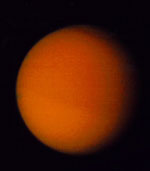
Image credit: NASA
Sarah Horst, a planetary sciences major at Caltech, helped astronomers track cloud formations on Saturn’s moon Titan using only a fourteen inch telescope – in Los Angeles. Researchers needed a way to track Titan night after night for several months, but no large observatory could provide this much time to carry out detailed observations. Horst set up an old teaching telescope to track the intensity of light coming from Titan. Whenever something unusual happened, her associates would contact Keck for detailed photographs.
Meet Sarah Horst, throwback. The planetary science major, a senior at the California Institute of Technology, spent six months engaged in a bit of old-time telescope observing. The work led to some breakthrough research about Saturn’s moon Titan, and indirectly led to funding for a new telescope at Caltech’s Palomar Observatory.
Horst, 21, was looking for a part-time job in the summer of her sophomore year, and was hired by Mike Brown, an associate professor of planetary astronomy. Brown and graduate student Antonin Bouchez knew there had been previous evidence of “weather” on Titan in the form of clouds. But that evidence was elusive. “Someone would look one year and think they saw a cloud, then look the next year and not see a cloud,” explains Brown. “What we were after was a way to look at Titan, night after night after night.”
The problem, of course, is that all of the large telescopes like Keck are incredibly busy, booked by astronomers from around the world who use the precious time for their own line of research. So Brown and Bouchez knew that obtaining large amounts of time for a single project like this was not going to happen.
The solution: Use an old teaching telescope–the hoary 14-inch Celestron telescope located on top of Caltech’s Robinson Lab–to do cutting edge science that couldn’t be done at the largest telescopes in the world, in Hawaii.
Though the power of the Robinson telescope is weak, and light pollution from Pasadena strong, which prevents imaging the actual clouds, the light reflecting from clouds could be imaged (the more clouds, the more light that’s reflected). All that was needed was someone who could come night after night and take multiple images.
Enter Horst, the self-described “lowly undergraduate.” For months, Horst spent her evenings in Robinson. “I did the setup, which involved a wheel that contained four light filters,” she explains. Each filter would capture a different wavelength of light. Software switched the filters; all she had to do, says Horst, was to orientate and focus the telescope.
Now, modern-day astronomers have it relatively easy when using their telescope time. Sure they’re up all night, but they sit on a comfortable chair in a warm room, hot coffee close at hand, and do their observing through a computer monitor that’s connected to a telescope.
Not Horst. She did it the old way, in discomfort. “A lot of times in December or January I’d go in late at night, and it would be freezing,” says Horst, who runs the 800-meter for the Caltech track team. “I’d wrap myself up in blankets.” Horst spent hours in the dark, since the old dome itself had to be dark. “I couldn’t even study,” she says, “although sometimes I tried to read by the light of the moon.”
A software program written by Bouchez plotted the light intensity from each image on a graph. When a particular image looked promising, Bouchez contacted Brown. As a frequent user of the Keck Observatory, which is powerful enough to take an image of the actual clouds, Brown was able to call colleagues who were using the Keck that night and quickly convince them that something exciting was going on. “It only took about ten minutes to get a quick image of Titan,” says Brown. “The funny part was having to explain to them that we knew there were clouds because we had seen the evidence in our 14-inch telescope in the middle of the L.A. basin.”
The result was “Direct Detection of Variable Tropospheric Clouds Near Titan’s South Pole,” which appeared in the December 19 journal Nature. It included this acknowledgement: “We thank . . . S. Horst for many nights of monitoring Titan in the cold.”
The paper has helped Brown obtain the funding to build a new 24-inch custom-built telescope. It will be placed in its own building atop Palomar Mountain, on the grounds of Caltech’s existing observatory. It’s also roboticized; Brown will control the scope from Pasadena via a computer program he has written.
He’ll use it for further observation of Titan and for other imaging, as well, such as fast-moving comets. “Most astronomy is big,” notes Brown; “big scopes looking at big, unchanging things, like galaxies. I like to look at changing things, which led to this telescope.”
What really made this project unique, though, according to Brown, is the Robinson scope. “Sarah was able to do something with this little telescope in Pasadena that no one in the world, on any of their larger professional telescopes on high, dark mountaintops, had been able to do,” he says. “Sometimes a good idea and stubbornness are better than the largest telescope in town.”
For Horst, while the work wasn’t intellectually challenging–“a trained monkey could have done it,” she says with a laugh–it was, nonetheless, “a cool project. Everything here is so theoretical and tedious, and so classroom orientated. So in that way it was a nice experience and reminded me what real science was about.”
Original Source: Caltech News Release
